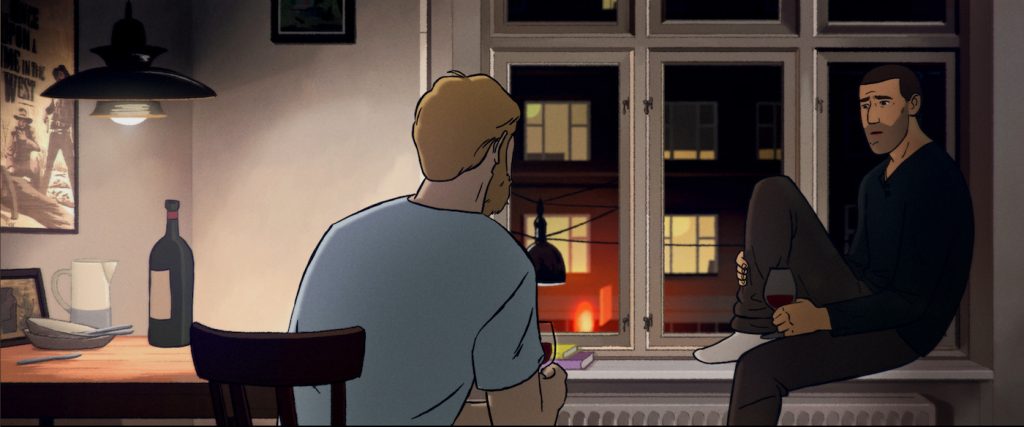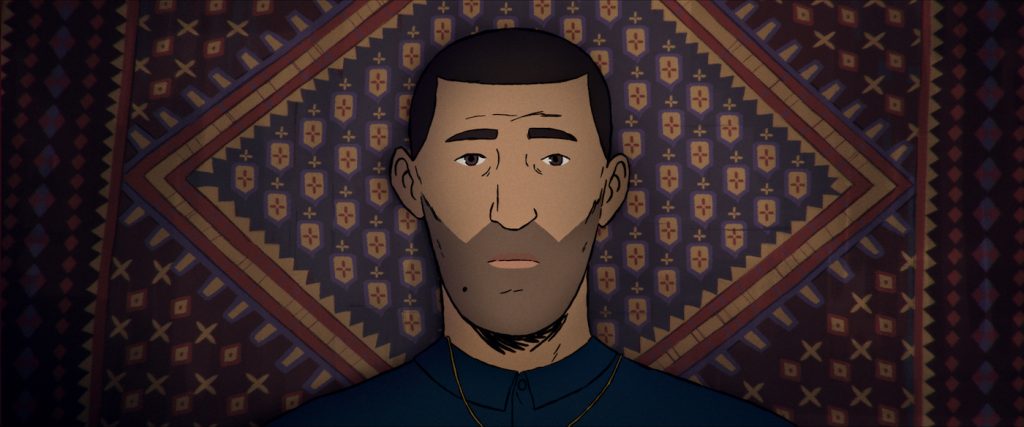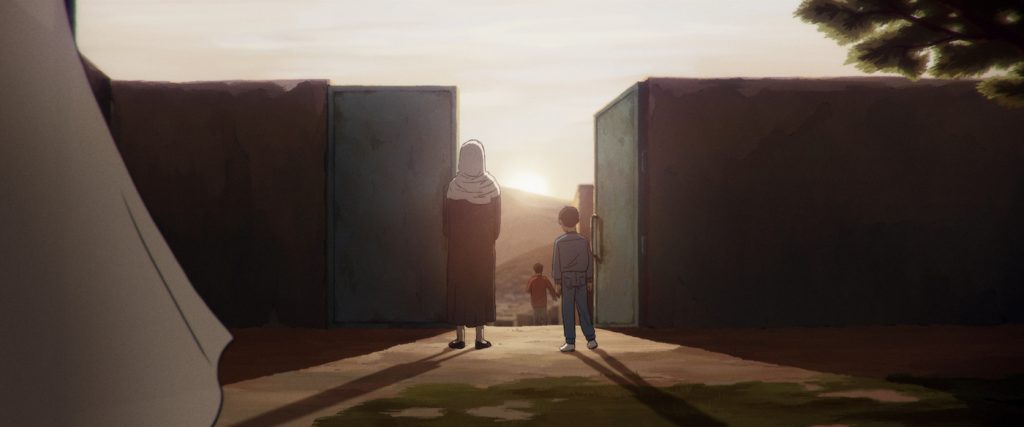“Flee” Director Jonas Rasmussen on His Historic Triple Oscar-Nominated Doc
Director Jonas Rasmussen remembers being a kid in Denmark and watching television news in 1990 when the first McDonald’s opened in Moscow, supposedly signifying a brave new world of post-Soviet capitalism. Rasmussen never could have imagined that the Afghan refugee standing just outside of the camera range would one day star in his acclaimed documentary Flee. The only movie in Oscar history to be triple-nominated in Best Foreign Language, Best Documentary, and Best Animation categories, Flee blends animation with bits of archival video footage to illustrate Amin Nawabi’s harrowing journey to freedom.
Visualized through a series of flashbacks, Amin Nawabi — not his real name — experiences a happy childhood that turns nightmarish when he escapes from Taliban-ruled Afghanistan after his father was abducted and never seen again. Today, Amin’s a successful scholar, happily married to his boyfriend and living without fear of reprisals in rural Denmark.
Rasmussen previously produced non-fiction radio stories and shot the 2015 true crime doc What He Did. Speaking from his home in Copenhagen, the filmmaker talks about taking a deep dive into animation to transform his friend’s painful memories into a riveting documentary.
Documentary makers traditionally try to maintain some kind of “objective” distance from their subjects, but Flee succeeds in part because of your personal relationship with Amin. How did you two meet?
The first time I saw Amin, he was on a train, very well dressed so he really stood out. To my surprise, he got off the same stop. It turned out he lived with a foster family in my little village. A while later we started meeting up every morning at the bus stop on the way to school. That’s where the friendship started.
In Flee, you appear as an animated version of yourself, the filmmaker, interviewing Amin. At one point, you even let him crash at your home when he’s going through a rough patch. It all feels very personal.
Because Amin’s story is seen from inside a friendship, we see that he’s not just a refugee. He’s also an academic, he’s also gay and a house owner and a cat lover, and all these things. I’ve known Amin for 25 years now, so it’s a much more open, nuanced conversation than you would normally get.

Amin’s lying on a couch with his eyes closed as you question him about his traumatic past. In some ways, it’s not unlike a psychotherapy session in the United States.
I have a background in radio documentaries and that’s where I learned this interview technique: you have your subjects lay down, close their eyes and talk in the present tense. They start to see memories and remember details in very descriptive ways so instead of just re-telling it, you’re re-living it. Amin had been carrying around all these secrets and memories for so many years, and with this way of talking, the past came alive.

Flee‘s three Academy Award nominations are pretty remarkable given that it’s the first time you’ve made an animation feature. How did you get started?
I was invited to an animation workshop in 2016 to talk about documentary ideas. I’d been thinking of making something with Amin for many years but hadn’t found the right form. [At the workshop] I realized Amin could be anonymous behind animation. He could talk about these traumatic experiences without being in the public eye or have people walk up to him and ask “What was it like being on that sinking boat?” In the end, that [animation format] is what enabled Amin to open up and say, “Okay, let’s do it.”
You recorded about 20 interviews with Amin over the span of four years. How did that raw audio material become animated?
Early in the process, we went through the broad strokes of his journey, going back and forth between memories and being in the present time. I’d write dialogue for sequences based on what he said and from there, the format together came quite early in terms of mixing archival footage with these different styles of animation.
Flee now and then intersperses news footage amid the animation.
The documentary footage serves as a reminder that the reason Amin had to flee is because of this world that we all belong to. I remember sitting at home watching the opening of the first McDonalds in Moscow on TV, so we included that when I learned that Amin had been there.
Off to the side getting his watch confiscated by corrupt Moscow cops.
He was really caught up in this fight between communism and capitalism, and that was the perfect metaphor. Authenticity was the keyword for the animation. We wanted Afghanistan in the eighties to look like Afghanistan during that time, Moscow in the nineties should look nineties. So we’d see what buildings looked like and re-draw them so that the animation belongs to the same world as the actual footage. It was important to remind people that this isn’t like Disney. It’s a story about a real person and a real voice.
Your animators developed a dark, impressionistic style to illustrate Amin’s most intense experiences. What was the idea behind that decision?
When Amin’s voice would slow down and he’d lose words, it no longer became about what things look like — it’s about an emotion he has inside. We needed to see that expressed in this more abstract, surreal style of animation. All along it was about listening to his voice and being as supportive and real as possible.
SPOILER ALERT
Flee uses that surreal style to illustrate a nightmarish chapter of Amin’s story when he and his family try to sneak into Sweden on a boat that starts leaking in the middle of the North Sea. They can’t swim, and suddenly a Norwegian cruiser shows up and everybody thinks they’re going to be saved. Instead. . .
Norway calls the border patrol and Amin gets dragged to Estonia and put in this worn-down refugee camp—basically, prison. I felt almost like one of those Norwegian tourists taking photos and just passing by. And then being a young teenager in a refugee camp, not knowing if he’s going to stay there for the rest of his life. That was a real gut punch to me. I’d known him for all these years, and I had no clue.

He’d gone through all of this while you’re enjoying a normal childhood in a western democracy.
When I went through all the interviews and put together the transcripts, what really hit me was how alike our lives had been up to a certain point. As kids we listened to the same music, we liked the same films. He played volleyball, I played soccer. Then all of a sudden he’s thrown into this crazy flight and goes through all these horrible things before he arrived in my hometown. And I continued playing soccer and listening to music and watching films as I’d always done. Amin’s life gave me perspective on my own story. I felt really lucky.
Amin finally arrives safe and sound in Denmark, but it’s not exactly a happy ending. Flee also deals with emotional damage suffered by Amin in the years that followed.
Amin kept all these secrets about his past which meant he had to keep a certain distance from people. He’d been my friend for 20 years when we started doing this and I had no clue how much this story affected him. That’s one of the fascinating things about human beings. They carry around so much that you never see. Amin’s successful in so many ways now, but he’ll be marked for the rest of his life by what happened to him.
How did Amin react when first saw this animated version of his life?
It was a very emotional experience. I showed Flee to Amin at his place. We sat down and watched the film on a computer. When it was over he turned to me and said. “I can’t separate myself from the craft of making a film, so you’ll have to ask someone else if it’s good.” But when we went to Sundance with Flee, he saw how well people responded to the universality of his story. That was meaningful for him. Amin, growing up, didn’t have many movies he could relate to. Now he has a chance to share his own story with millions of refugees around the world.
Art director Jess Nicholls and the animators at Sun Creatures Studio transformed Amin’s audio recollections with great flair. Coming from your background in radio and video-based documentaries, how did you react to their contributions?
I was blown away. I had no experience whatsoever with animation so these artists kind of took me by the hand and taught me so much. When you see them draw something, it’s a little bit like watching people who can sing well: these beautiful things come directly out of their bodies. For me, I felt lucky to work with such amazing artists.
For more interviews with Oscar nominees, check out these stories:
How the Oscar-Nominated “tick, tick…BOOM!” Editors Evoked the Excitement of Live Theatre
Oscar-Nominated “Dune” DP Greig Fraser on Taming an Epic Sci-Fi Beast
Oscar-Nominated “Dune” Screenwriter Jon Spaihts on Decoding Frank Herbert’s Tome
Oscar-Nominated Re-Recording Sound Mixer Paul Massey on “No Time To Die”
Featured image: Amin and Kasper in “Flee.” Courtesy Neon.



